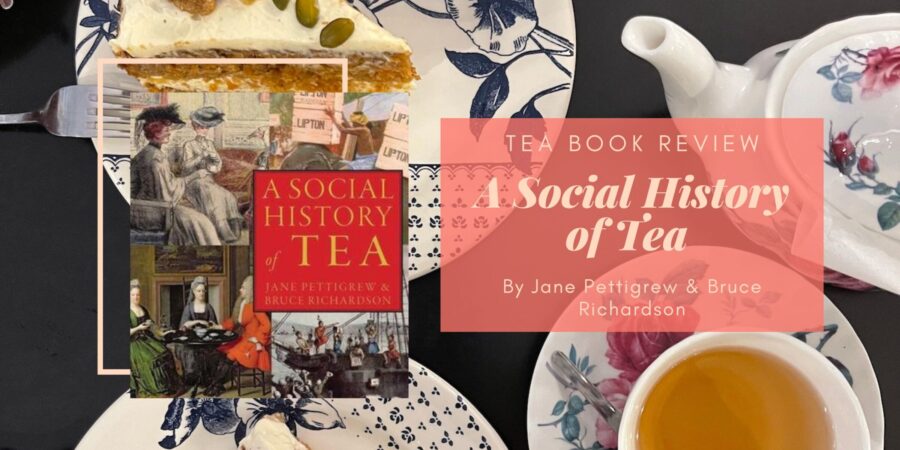I have wanted to read this book ever since I heard of it. Although I swing back and forth between reading the Western and Asian histories of tea, that’s because I want to get a sense of the whole picture. A Social History of Tea covers the rise and impact of tea in Britain and America, from the 17th to the 21st Century.
Reading the book, tea seems to have made a quiet entrance into England. Samuel Pepys talked about sending for a cup of tea (spelled “tee”) for the first time, but the high price of tea made it inaccessible to all but the wealthy. Because of the high price of tea, the lady of the house was the one who was in charge of keeping the tea – it was far too valuable to be entrusted to the servants. As for how it came into the country, both England and America received tea through the Dutch East India Company.
Something interesting I learned was that pottery was imported before tea was imported. I always thought of them as a set, so this was interesting. The book also mentions that at first, full sets of China were uncommon, since the cargo was shipped out in mixed batches. The Europeans did start making pottery after the Chinese and Japanese style, but “it was not until the mid-eighteenth century that they produced anything to seriously rival the quality and beauty of Chinese and Japanese wares.” This was also a good reminder that although I tend to see Chinese and Western tea ware as very different things, Western tea was started off as Chinese tea ware. But as they developed their own culture, the way they drank tea and the vessels they used changed.
Another surprise was that Americans starting like tea in the late seventeenth century, since I don’t really have an impression of America as a tea drinking country.
As the book moves into the eighteenth century, the book starts to talk about illegal tea. Due to the high taxes, tea was one of the items that was often smuggled into the country. The book puts tea smouch (fake tea), which I first learnt about from Tea With Jane Austen, in the same category as adulterated teas from China. Unlike A Thirst for Empire, however, the book doesn’t go into the different reasons why black tea emerged as the tea of choice, but simply states that because “the consuming public knew that it was easier to adulterate green tea, more and more people began to buy only black.”
Another interesting thing I learnt was that as the common folk started developing a taste for tea, house servants “often had their wages calculated to include a tea allowance.” I’d advocate for this at my workplace, but we already have more tea than we can drink!
The eighteenth century was also when the Boston Tea Party took place and the book provides an overview of the event.
When we head into the nineteenth century, we get Americans growing tea and the emergence of Lipton tea company. The book also talks about tea in literature, including a section on one of my favourite authors – Jane Austen. The book Tea With Jane Austen definitely has more detail, though.
There is a delightful section on afternoon tea, its etiquette, and even the menu and dress! The concept of tea gowns was very interesting. The tea gown is something “designed to allow the female body a freedom that the more formal Victorian dress did not”. It was considered fairly casual (and not suitable for going out), but nice enough that you can entertain your friends if they come to visit you.
The chapter also talks about the temperance movement, although the book doesn’t connect it to afternoon tea, instead only mentioning “the accepted tea legend” that we always hear. Perhaps Erika Rappaport’s theory of temperance tea parties as the origin of afternoon tea is less well-known than I imagine. I do, however, still find it persuasive. In fact, A Social History of Tea mentions a tea party held during the Christmas of 1833 and says in a separate place that afternoon tea developed “sometime between the late 1830s and early 1840s”, so even with their timeline, the theory of temperance tea parties as the root of afternoon tea makes sense.
When tea enters the twentieth century, we start talking about tea in wartime, along with modern tea ware, the invention of the teabag, and the continued development of the tea gown. In America, tea room management courses started appearing in the 1920s, as more and more women started their own tea rooms. One course taught students how to deal with “all the major issues involved in running a tea room – menu planning, recipes, equipment buying, portion control, accounting and employees.” They taught things like making tea balls to save time and gave tips on how to name your establishment. After reading about them, I wanted to enroll in one such course!
Unfortunately, the good times don’t last and the quality of afternoon tea started to decline. This segues into the final chapter, about tea in the twenty-first century, which looks at the revitalisation of tea.
Overall, this is a pretty interesting book. It doesn’t go into as much detail as say, A Thirst for Empire, but it does cover two tea drinking countries over five centuries. That’s a lot of ground to cover and the book does a good job recapping the history of tea. I don’t think it’s the only book you need (definitely not), but it’s a nice introduction to the Western history of tea. That said, if you’re only interested in the history of tea in Britain and her colonies, then A Thirst for Empire is probably more comprehensive and what you need.
